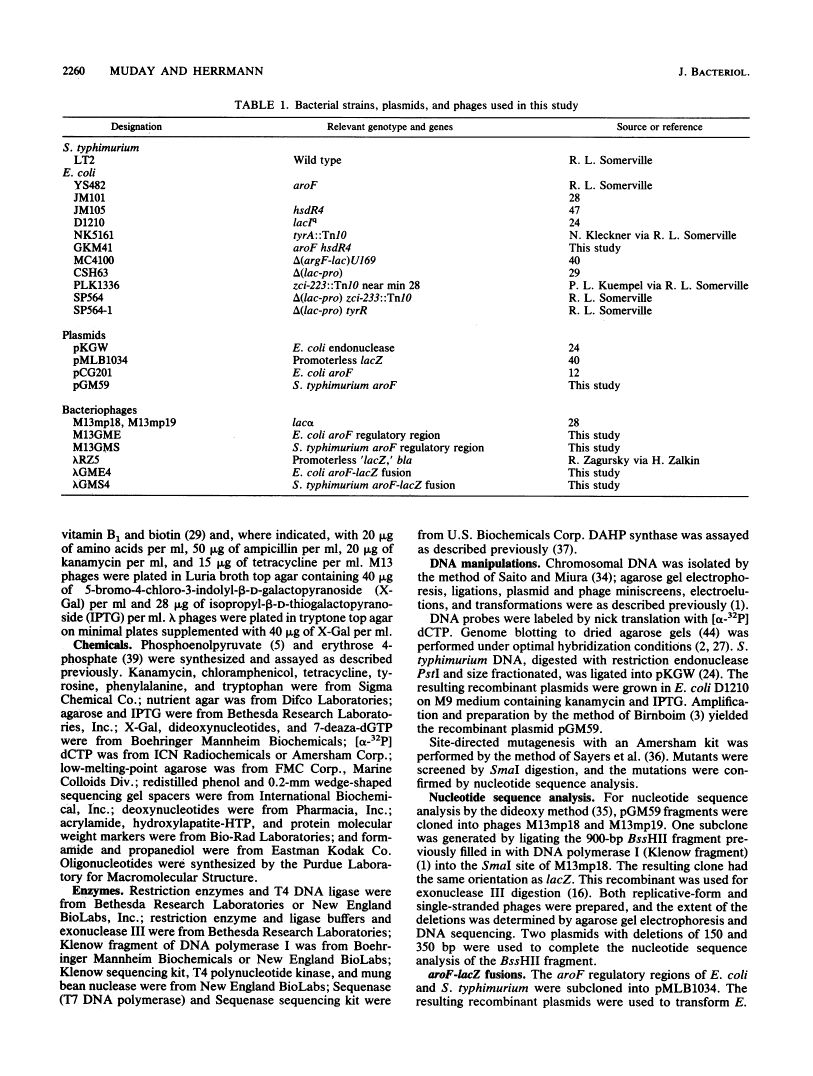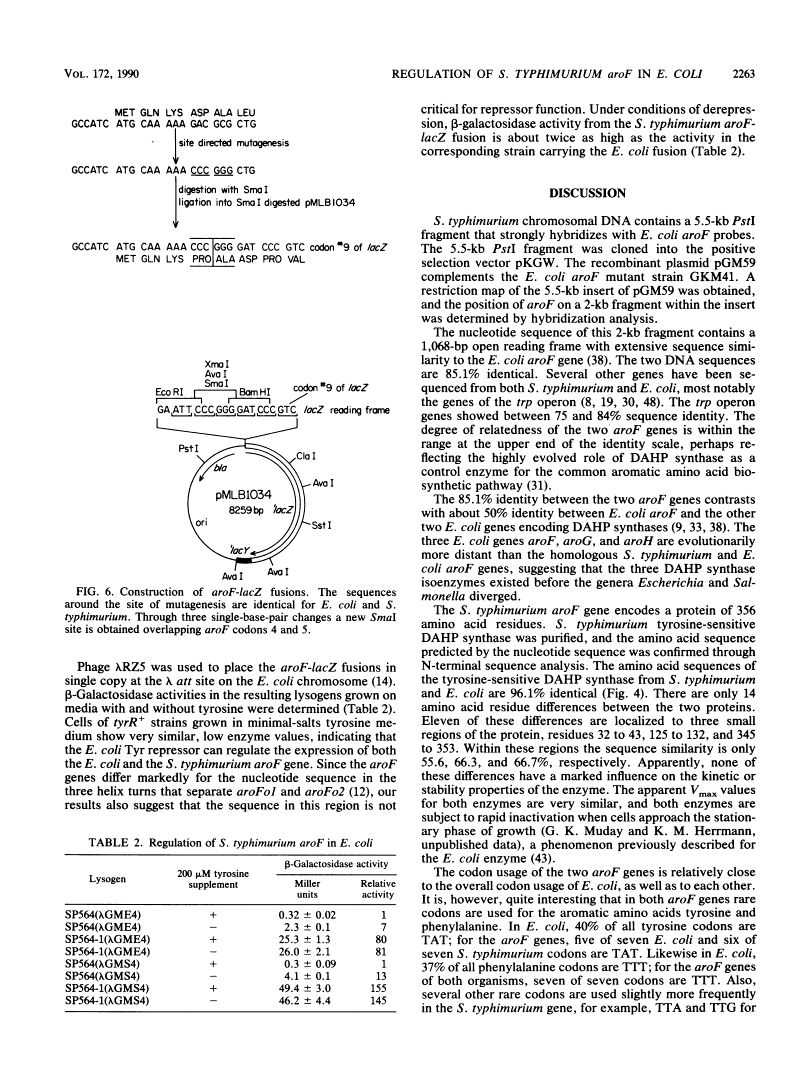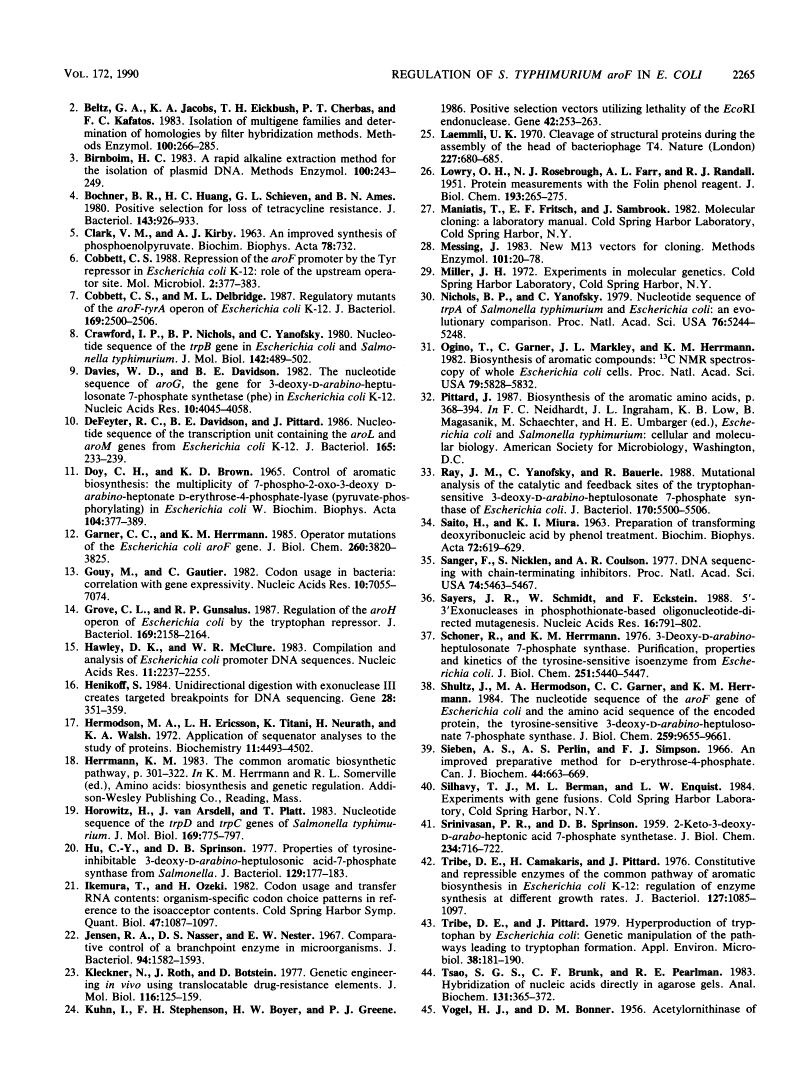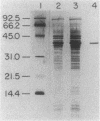Abstract
Free full text

Regulation of the Salmonella typhimurium aroF gene in Escherichia coli.
Abstract
The Salmonella typhimurium aroF gene, encoding the tyrosine-sensitive 3-deoxy-D-arabino-heptulosonate 7-phosphate (DAHP) synthase, was localized to a chromosomal PstI fragment by Southern blotting with an Escherichia coli aroF probe. This fragment was cloned by screening a plasmid library for complementation of an E. coli aroF mutant. The nucleotide sequence of S. typhimurium aroF was determined and compared with its E. coli homolog. The nucleotide sequences are 85.1% identical, and the corresponding amino acid sequences are 96.1% identical. The E. coli genes encoding the three DAHP synthase isoenzymes are evolutionarily more distant from one another than are the homologous aroF genes of E. coli and S. typhimurium. The S. typhimurium aroF regulatory region contains three imperfect palindromes, two upstream of the promoter and one overlapping the promoter, that are nearly identical to operators aroFo1, aroFo2, and TyrR box 1 of E. coli. The aroFo1 and aroFo2 sequences of the two organisms are each separated by three turns of the DNA helix with no sequence similarity. The 5' ends of the aroF transcripts for both organisms contain untranslated regions with potential stem-loop structures. Translational fusions of the aroF regulatory regions to lacZ were constructed and then introduced in single copy into the E. coli chromosome. beta-Galactosidase assays for tyrR-mediated regulation of aroF-lacZ expression revealed that the E. coli TyrR repressor apparently recognizes the operators of both organisms with about equal efficiency.
Full text
Full text is available as a scanned copy of the original print version. Get a printable copy (PDF file) of the complete article (1.5M), or click on a page image below to browse page by page. Links to PubMed are also available for Selected References.
Images in this article
Selected References
These references are in PubMed. This may not be the complete list of references from this article.
- Beltz GA, Jacobs KA, Eickbush TH, Cherbas PT, Kafatos FC. Isolation of multigene families and determination of homologies by filter hybridization methods. Methods Enzymol. 1983;100:266–285. [Abstract] [Google Scholar]
- Birnboim HC. A rapid alkaline extraction method for the isolation of plasmid DNA. Methods Enzymol. 1983;100:243–255. [Abstract] [Google Scholar]
- Bochner BR, Huang HC, Schieven GL, Ames BN. Positive selection for loss of tetracycline resistance. J Bacteriol. 1980 Aug;143(2):926–933. [Europe PMC free article] [Abstract] [Google Scholar]
- Cobbett CS. Repression of the aroF promoter by the TyrR repressor in Escherichia coli K-12: role of the 'upstream' operator site. Mol Microbiol. 1988 May;2(3):377–383. [Abstract] [Google Scholar]
- Cobbett CS, Delbridge ML. Regulatory mutants of the aroF-tyrA operon of Escherichia coli K-12. J Bacteriol. 1987 Jun;169(6):2500–2506. [Europe PMC free article] [Abstract] [Google Scholar]
- Crawford IP, Nichols BP, Yanofsky C. Nucleotide sequence of the trpB gene in Escherichia coli and Salmonella typhimurium. J Mol Biol. 1980 Oct 5;142(4):489–502. [Abstract] [Google Scholar]
- Davies WD, Davidson BE. The nucleotide sequence of aroG, the gene for 3-deoxy-D-arabinoheptulosonate-7-phosphate synthetase (phe) in Escherichia coli K12. Nucleic Acids Res. 1982 Jul 10;10(13):4045–4058. [Europe PMC free article] [Abstract] [Google Scholar]
- DeFeyter RC, Davidson BE, Pittard J. Nucleotide sequence of the transcription unit containing the aroL and aroM genes from Escherichia coli K-12. J Bacteriol. 1986 Jan;165(1):233–239. [Europe PMC free article] [Abstract] [Google Scholar]
- Doy CH, Brown KD. Control of aromatic biosynthesis: the multiplicity of 7-phospho-2-oxo-3-deoxy-D-arabino-heptonate D-erythrose-4-phosphate-lyase (pyruvate-phosphorylating) in Escherichia coli W. Biochim Biophys Acta. 1965 Jul 8;104(2):377–389. [Abstract] [Google Scholar]
- Garner CC, Herrmann KM. Operator mutations of the Escherichia coli aroF gene. J Biol Chem. 1985 Mar 25;260(6):3820–3825. [Abstract] [Google Scholar]
- Gouy M, Gautier C. Codon usage in bacteria: correlation with gene expressivity. Nucleic Acids Res. 1982 Nov 25;10(22):7055–7074. [Europe PMC free article] [Abstract] [Google Scholar]
- Grove CL, Gunsalus RP. Regulation of the aroH operon of Escherichia coli by the tryptophan repressor. J Bacteriol. 1987 May;169(5):2158–2164. [Europe PMC free article] [Abstract] [Google Scholar]
- Hawley DK, McClure WR. Compilation and analysis of Escherichia coli promoter DNA sequences. Nucleic Acids Res. 1983 Apr 25;11(8):2237–2255. [Europe PMC free article] [Abstract] [Google Scholar]
- Henikoff S. Unidirectional digestion with exonuclease III creates targeted breakpoints for DNA sequencing. Gene. 1984 Jun;28(3):351–359. [Abstract] [Google Scholar]
- Hermodson MA, Ericsson LH, Titani K, Neurath H, Walsh KA. Application of sequenator analyses to the study of proteins. Biochemistry. 1972 Nov 21;11(24):4493–4502. [Abstract] [Google Scholar]
- Horowitz H, Van Arsdell J, Platt T. Nucleotide sequence of the trpD and trpC genes of Salmonella typhimurium. J Mol Biol. 1983 Oct 5;169(4):775–797. [Abstract] [Google Scholar]
- Hu CY, Sprinson DB. Properties of tyrosine-inhibitable 3-deoxy-d-arabinoheptulosonic acid-7-phosphate synthase from Salmonella. J Bacteriol. 1977 Jan;129(1):177–183. [Europe PMC free article] [Abstract] [Google Scholar]
- Ikemura T, Ozeki H. Codon usage and transfer RNA contents: organism-specific codon-choice patterns in reference to the isoacceptor contents. Cold Spring Harb Symp Quant Biol. 1983;47(Pt 2):1087–1097. [Abstract] [Google Scholar]
- Jensen RA, Nasser DS, Nester EW. Comparative control of a branch-point enzyme in microorganisms. J Bacteriol. 1967 Nov;94(5):1582–1593. [Europe PMC free article] [Abstract] [Google Scholar]
- Kleckner N, Roth J, Botstein D. Genetic engineering in vivo using translocatable drug-resistance elements. New methods in bacterial genetics. J Mol Biol. 1977 Oct 15;116(1):125–159. [Abstract] [Google Scholar]
- Kuhn I, Stephenson FH, Boyer HW, Greene PJ. Positive-selection vectors utilizing lethality of the EcoRI endonuclease. Gene. 1986;42(3):253–263. [Abstract] [Google Scholar]
- Laemmli UK. Cleavage of structural proteins during the assembly of the head of bacteriophage T4. Nature. 1970 Aug 15;227(5259):680–685. [Abstract] [Google Scholar]
- LOWRY OH, ROSEBROUGH NJ, FARR AL, RANDALL RJ. Protein measurement with the Folin phenol reagent. J Biol Chem. 1951 Nov;193(1):265–275. [Abstract] [Google Scholar]
- Messing J. New M13 vectors for cloning. Methods Enzymol. 1983;101:20–78. [Abstract] [Google Scholar]
- Nichols BP, Yanofsky C. Nucleotide sequences of trpA of Salmonella typhimurium and Escherichia coli: an evolutionary comparison. Proc Natl Acad Sci U S A. 1979 Oct;76(10):5244–5248. [Europe PMC free article] [Abstract] [Google Scholar]
- Ogino T, Garner C, Markley JL, Herrmann KM. Biosynthesis of aromatic compounds: 13C NMR spectroscopy of whole Escherichia coli cells. Proc Natl Acad Sci U S A. 1982 Oct;79(19):5828–5832. [Europe PMC free article] [Abstract] [Google Scholar]
- Ray JM, Yanofsky C, Bauerle R. Mutational analysis of the catalytic and feedback sites of the tryptophan-sensitive 3-deoxy-D-arabino-heptulosonate-7-phosphate synthase of Escherichia coli. J Bacteriol. 1988 Dec;170(12):5500–5506. [Europe PMC free article] [Abstract] [Google Scholar]
- SAITO H, MIURA KI. PREPARATION OF TRANSFORMING DEOXYRIBONUCLEIC ACID BY PHENOL TREATMENT. Biochim Biophys Acta. 1963 Aug 20;72:619–629. [Abstract] [Google Scholar]
- Sanger F, Nicklen S, Coulson AR. DNA sequencing with chain-terminating inhibitors. Proc Natl Acad Sci U S A. 1977 Dec;74(12):5463–5467. [Europe PMC free article] [Abstract] [Google Scholar]
- Sayers JR, Schmidt W, Eckstein F. 5'-3' exonucleases in phosphorothioate-based oligonucleotide-directed mutagenesis. Nucleic Acids Res. 1988 Feb 11;16(3):791–802. [Europe PMC free article] [Abstract] [Google Scholar]
- Schoner R, Herrmann KM. 3-Deoxy-D-arabino-heptulosonate 7-phosphate synthase. Purification, properties, and kinetics of the tyrosine-sensitive isoenzyme from Escherichia coli. J Biol Chem. 1976 Sep 25;251(18):5440–5447. [Abstract] [Google Scholar]
- Shultz J, Hermodson MA, Garner CC, Herrmann KM. The nucleotide sequence of the aroF gene of Escherichia coli and the amino acid sequence of the encoded protein, the tyrosine-sensitive 3-deoxy-D-arabino-heptulosonate 7-phosphate synthase. J Biol Chem. 1984 Aug 10;259(15):9655–9661. [Abstract] [Google Scholar]
- Sieben AS, Perlin AS, Simpson FJ. An improved preparative method for D-erythrose 4-phosphate. Can J Biochem. 1966 Jun;44(6):663–669. [Abstract] [Google Scholar]
- SRINIVASAN PR, SPRINSON DB. 2-Keto-3-deoxy-D-arabo-heptonic acid 7-phosphate synthetase. J Biol Chem. 1959 Apr;234(4):716–722. [Abstract] [Google Scholar]
- Tribe DE, Camakaris H, Pittard J. Constitutive and repressivle enzymes of the common pathway of aromatic biosynthesis in Escherichia coli K-12: regulation of enzyme synthesis at different growth rates. J Bacteriol. 1976 Sep;127(3):1085–1097. [Europe PMC free article] [Abstract] [Google Scholar]
- Tribe DE, Pittard J. Hyperproduction of tryptophan by Escherichia coli: genetic manipulation of the pathways leading to tryptophan formation. Appl Environ Microbiol. 1979 Aug;38(2):181–190. [Europe PMC free article] [Abstract] [Google Scholar]
- Tsao SG, Brunk CF, Pearlman RE. Hybridization of nucleic acids directly in agarose gels. Anal Biochem. 1983 Jun;131(2):365–372. [Abstract] [Google Scholar]
- Wray W, Boulikas T, Wray VP, Hancock R. Silver staining of proteins in polyacrylamide gels. Anal Biochem. 1981 Nov 15;118(1):197–203. [Abstract] [Google Scholar]
- Yanisch-Perron C, Vieira J, Messing J. Improved M13 phage cloning vectors and host strains: nucleotide sequences of the M13mp18 and pUC19 vectors. Gene. 1985;33(1):103–119. [Abstract] [Google Scholar]
- Yanofsky C, vanCleemput M. Nucleotide sequence of trpE of Salmonella typhimurium and its homology with the corresponding sequence of Escherichia coli. J Mol Biol. 1982 Mar 5;155(3):235–246. [Abstract] [Google Scholar]
Associated Data
Articles from Journal of Bacteriology are provided here courtesy of American Society for Microbiology (ASM)
Full text links
Read article at publisher's site: https://doi.org/10.1128/jb.172.5.2259-2266.1990
Read article for free, from open access legal sources, via Unpaywall:
https://europepmc.org/articles/pmc208857?pdf=render
Free to read at jb.asm.org
http://jb.asm.org/cgi/content/abstract/172/5/2259
Free after 4 months at jb.asm.org
http://jb.asm.org/cgi/reprint/172/5/2259
Citations & impact
Impact metrics
Citations of article over time
Article citations
Serine 187 is a crucial residue for allosteric regulation of Corynebacterium glutamicum 3-deoxy-D-arabino-heptulosonate-7-phosphate synthase.
FEMS Microbiol Lett, 194(1):59-64, 01 Jan 2001
Cited by: 13 articles | PMID: 11150666
Substrate ambiguity of 3-deoxy-D-manno-octulosonate 8-phosphate synthase from Neisseria gonorrhoeae in the context of its membership in a protein family containing a subset of 3-deoxy-D-arabino-heptulosonate 7-phosphate synthases.
J Bacteriol, 180(1):119-127, 01 Jan 1998
Cited by: 33 articles | PMID: 9422601 | PMCID: PMC106857
Genetic map of Salmonella typhimurium, edition VIII.
Microbiol Rev, 59(2):241-303, 01 Jun 1995
Cited by: 75 articles | PMID: 7603411 | PMCID: PMC239362
Review Free full text in Europe PMC
The tyrosine repressor negatively regulates aroH expression in Escherichia coli.
J Bacteriol, 173(12):3930-3932, 01 Jun 1991
Cited by: 13 articles | PMID: 1675635 | PMCID: PMC208031
The pheA/tyrA/aroF region from Erwinia herbicola: an emerging comparative basis for analysis of gene organization and regulation in enteric bacteria.
J Mol Evol, 36(2):107-120, 01 Feb 1993
Cited by: 7 articles | PMID: 8094464
Go to all (7) article citations
Data
Data behind the article
This data has been text mined from the article, or deposited into data resources.
BioStudies: supplemental material and supporting data
Similar Articles
To arrive at the top five similar articles we use a word-weighted algorithm to compare words from the Title and Abstract of each citation.
Operator mutations of the Escherichia coli aroF gene.
J Biol Chem, 260(6):3820-3825, 01 Mar 1985
Cited by: 26 articles | PMID: 2857723
Cloning of an aroF allele encoding a tyrosine-insensitive 3-deoxy-D-arabino-heptulosonate 7-phosphate synthase.
J Bacteriol, 172(11):6581-6584, 01 Nov 1990
Cited by: 34 articles | PMID: 1977738 | PMCID: PMC526849
The pheA/tyrA/aroF region from Erwinia herbicola: an emerging comparative basis for analysis of gene organization and regulation in enteric bacteria.
J Mol Evol, 36(2):107-120, 01 Feb 1993
Cited by: 7 articles | PMID: 8094464
Determinants of DNA sequence divergence between Escherichia coli and Salmonella typhimurium: codon usage, map position, and concerted evolution.
J Mol Evol, 33(1):23-33, 01 Jul 1991
Cited by: 140 articles | PMID: 1909371
Review













